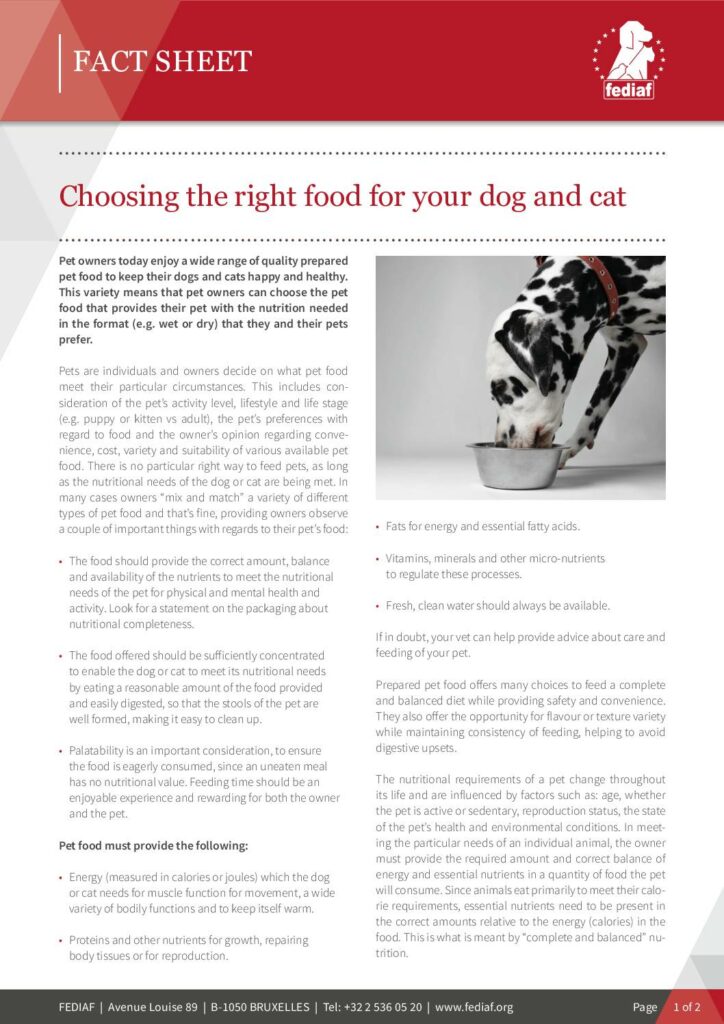Pet owners today enjoy a wide range of quality prepared pet food to keep their dogs and cats happy and healthy. This variety means that pet owners can choose the pet food that provides their pet with the nutrition needed in the format (e.g. wet or dry) that they and their pets prefer.
Pets are individuals and owners decide on what pet food meet their particular circumstances. This includes consideration of the pet’s activity level, lifestyle and life stage (e.g. puppy or kitten vs adult), the pet’s preferences with regard to food and the owner’s opinion regarding convenience, cost, variety and suitability of various available pet food. There is no particular right way to feed pets, as long as the nutritional needs of the dog or cat are being met. In many cases owners “mix and match” a variety of different types of pet food and that’s fine, providing owners observe a couple of important things with regards to their pet’s food:
- The food should provide the correct amount, balance and availability of the nutrients to meet the nutritional needs of the pet for physical and mental health and activity. Look for a statement on the packaging about nutritional completeness.
- The food offered should be sufficiently concentrated to enable the dog or cat to meet its nutritional needs by eating a reasonable amount of the food provided and easily digested, so that the stools of the pet are well formed, making it easy to clean up.
- Palatability is an important consideration, to ensure the food is eagerly consumed, since an uneaten meal has no nutritional value. Feeding time should be an enjoyable experience and rewarding for both the owner and the pet.
Pet food must provide the following:
- Energy (measured in calories or joules) which the dog or cat needs for muscle function for movement, a wide variety of bodily functions and to keep itself warm.
- Proteins and other nutrients for growth, repairing body tissues or for reproduction.
- Fats for energy and essential fatty acids.
- Vitamins, minerals and other micro-nutrients to regulate these processes.
- Fresh, clean water should always be available.
If in doubt, your vet can help provide advice about care and feeding of your pet.
Prepared pet food offers many choices to feed a complete and balanced diet while providing safety and convenience. They also offer the opportunity for flavour or texture variety while maintaining consistency of feeding, helping to avoid digestive upsets.
The nutritional requirements of a pet change throughout its life and are influenced by factors such as: age, whether the pet is active or sedentary, reproduction status, the state of the pet’s health and environmental conditions. In meeting the particular needs of an individual animal, the owner must provide the required amount and correct balance of energy and essential nutrients in a quantity of food the pet will consume. Since animals eat primarily to meet their calorie requirements, essential nutrients need to be present in the correct amounts relative to the energy (calories) in the food. This is what is meant by “complete and balanced” nutrition.
The choice of food type for pet dogs and cats is very much a personal matter. While various factors are involved in this choice, the main points to consider are:
- Owner preference for a type of feeding (e.g canned, dry, semi-moist, or a combination).
- The feeding habits of the pet. Every pet is different and each may have personal preferences for canned, chilled rolls and tubs, pouch or dry pet food. Of course, many pets enjoy the variety offered by combining these different kinds of pet food.
- Economic considerations and convenience.
Functional pet food, treats & veterinary diets
Over recent years, there has been rapid development in the range of treats and functional pet food available for pets. These include treats and snacks to help training your puppy or simply reward your cat or dog. There is a wide variety of nutrient fortified supplements, dry pet food and treats designed to assist in teeth and gum health, food for cats prone to fur balls and many other kinds of specialised products.
Treats provide an important mechanism for strengthening the bond between pet and owner and can be a great motivating tool for training. In addition, some treats have positive effects in areas such as oral health and joint health. They should be fed in moderation, according to specific feeding guides, and as part of a healthy feeding regime.
Veterinarians also stock and prescribe a wide range of veterinary dietetic pet food designed to provide for a pet’s specific needs and to assist in the management of a range of medical conditions. Your veterinarian can provide professional advice regarding feeding and care for your pet.
How much should I feed my pet?
Feeding recommendations are usually included on prepared pet food packaging and these provide owners with a good guide to get started, although it should be recognised that recommendations are intended as a guide only to provide an approximate estimate of a pet’s nutritional needs. As dogs and cats vary significantly in their size, activity level, life stage and the environment in which they are kept, over time the owner needs to keep an eye on the body condition of the pet and decide whether to feed more or less and what kind of food is best suited to their requirements. Pets are adaptable and there are many different and equally successful ways to feed pets well. If in doubt, your veterinarian can provide further advice.
There is a wide range of quality, prepared commercial pet food now available through supermarkets and mass merchandise outlets, specialist pet supply retailers, veterinary clinics, rural supply outlets and on- line retailers, providing today’s pet owner with many choices and product types.
This pet food provide a great basis for your pet’s diet, delivering balanced nutrition, variety, palatability, sustainability, consistency and safety, making for a satisfied pet and owner.
